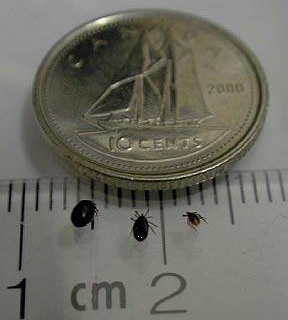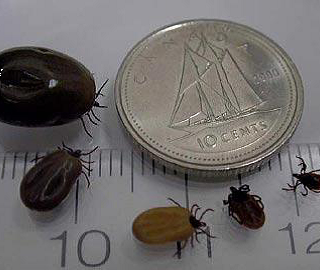The information contained on this page is also available in a printable PDF format here
What is Lyme disease?
Lyme disease is a bacterial infection transmitted to humans by a bite from an infected black-legged tick. Ticks attach to skin and feed on the blood of animals (such as rodents, birds, deer, dogs, and humans). The most common time of year for these bites are spring, summer, and fall when ticks are most active and when people are spending more time outdoors. For more information about black-legged ticks and other ticks of Newfoundland and Labrador (including photos) visit The Ticks of Newfoundland
Have there been confirmed cases of Lyme disease in Newfoundland and Labrador?
Although NL is not considered endemic for Lyme Disease, ten cases have been diagnosed in NL since 1991. All of these infections were acquired by persons travelling to known Lyme disease endemic areas outside of the province.
How do people get Lyme disease?
Lyme disease is spread to humans from the bite of a black-legged tick infected with the bacterium Borrelia burgdorferi. Lyme disease cannot be transmitted from person to person. Most humans are infected through the bite of an immature tick (nymph) during the spring, summer and fall months. Nymphs are the size of a poppy seed and difficult to see. Therefore, the nymphs have ample time to feed and transmit the infection (ticks need to be attached at least 24 to 36 hours to transmit the infection). Adult ticks are the size of a sesame seed and are most active during late summer and fall.
Ticks wait on grass, bushes, or shrubs for an animal or human to come by. Ticks can’t jump or fly. If the animal or human brushes past the tick, it can crawl on to the skin or clothes and then travel on the body to find a suitable location to attach for a blood meal.
Currently there are no areas in Newfoundland and Labrador that are believed to have permanent populations of black-legged ticks. However, low numbers of these ticks have been found, mostly on pet animals, and it is thought these are ticks carried into the province by migratory birds. Some of these ticks have been infected with the bacteria that causes Lyme disease. For more detailed information regarding how Lyme disease affects animals in the province please visit Lyme Disease in Newfoundland
How can tick bites be prevented?
Ticks, and thus tick bites, are fairly common in eastern and central Canada and the United States. Black-legged ticks are less frequently found in Newfoundland and Labrador, compared to other eastern Canadian provinces such as New Brunswick, Nova Scotia, and Quebec. For information on Lyme disease risk areas in Canada, visit: Lyme disease: Prevention and risks.
When visiting Lyme disease risk areas, such as Nova Scotia, New Brunswick, or Quebec, the following precautions can reduce the chances of being bitten by a tick:
- Avoid wooded and brushy areas that contain high grass and leaf litter;
- If you go into wooded areas, walk in the center of cleared paths;
- Wear light coloured long-sleeved shirts and long pants to spot ticks more easily. Tuck your shirt into your pants, and pull your socks over your pant legs;
- Use an insect repellent such as DEET or Icaridin (always read and follow product label directions before applying);
- Check yourself, your family and pets after being in an area where ticks may be present; and,
- Shower or bathe within two hours of returning from outdoor activities to wash away loose ticks.
After going outdoors, do a full body tick check on yourself, your family and pets. Scan the entire body – a tick can sometimes resemble a mole and be as small as the period at the end of this sentence.
How can a tick be removed?
Removing ticks within 24-36 hours usually prevents infection. If you find a tick attached to your skin, make sure you remove it carefully as follows:
- Use clean tweezers, grasp the head as close to the skin as possible and pull slowly straight out.
- Afterwards, wash the bite site with soap and water or disinfect with alcohol hand sanitizer.
- If mouthparts break off, remove them with tweezers or, if you are unable to remove them easily, leave it alone and let the skin heal.
After removing the tick, the skin should be cleaned with soap and water or disinfected with alcohol or hand sanitizer. Wash your hands after removing the tick. Store the tick in a closed container if you are going to transport the tick for photo identification later.
Starting in 2020, NL has adopted the eTick image-based identification platform developed by researchers at Bishop’s University, and funded by the Public Health Agency of Canada. NL residents can now submit images of ticks found on animals, humans or in various habitats to have it identified by trained experts. In addition to providing submitters with rapid tick identification results and information relevant to the public, the eTick platform will provide a better understanding of tick distribution in NL. Click here to access the eTick platform, including links to download the free mobile eTick app.
For more information about removing ticks, including a photo, visit Ticks and Lyme Disease.
What are the signs and symptoms of Lyme disease?
Early signs and symptoms of Lyme disease usually start three days to one month after being bitten by an infected tick. Although symptoms of Lyme disease can be different from person to person, most people experience mild flu-like symptoms soon after being bitten. A small number may have more serious symptoms, sometimes weeks after the bite.
Early signs and symptoms of Lyme disease may include:
- Fever
- Chills
- Headache
- Fatigue
- Muscle and joint aches
- Swollen lymph nodes
- Rash, sometimes shaped like a bull’s eye (Erythema migrans (EM rash))
Lyme disease can be treated, but if left untreated, it can cause more severe symptoms weeks to years after the bite. These can include:
- Severe headaches
- Additional EM skin rashes
- Facial paralysis
- Recurring arthritis
- Heart disorders
- Neurological disorders
For more information, visit Lyme disease: Symptoms and treatment.
Is there a test for Lyme disease?
Diagnosing Lyme disease can be difficult as symptoms can vary between individuals and can also be similar to other illnesses. Health care providers use information on symptoms, potential exposure to infected black-legged ticks, and laboratory blood testing to diagnose the disease. Laboratory tests alone may not always detect Lyme disease, especially if it is in the early stages of infection. If an individual develops symptoms of Lyme disease after being bitten by a tick or visiting a known at risk area for Lyme disease, they should see their family doctor right away. The earlier a diagnosis is made, the greater the chance of a successful treatment. For more information about diagnosing Lyme disease visit Lyme disease: Symptoms and treatment.
Can Lyme disease be treated?
Yes, antibiotics are used to treat Lyme disease. Lyme disease is rarely life threatening, but if left untreated, more serious symptoms can develop. Some people experience symptoms that continue more than six months after treatment. Research continues into the causes of these persistent symptoms and possible treatment methods. If an individual suspects Lyme disease, they should consult a health care provider as soon as possible.
Websites for more information:
Lyme disease: https://www.canada.ca/en/public-health/services/diseases/lyme-disease.html
How to remove a tick: https://www.gov.nl.ca/ffa/programs-and-funding/programs/animals/health/ticks/removeticks/
Ticks and Lyme disease in NL: https://www.gov.nl.ca/ffa/programs-and-funding/programs/animals/health/lymedisease/
eTick photo identification service: https://www.etick.ca/
Updated: May 2018


